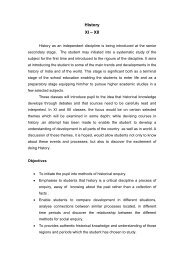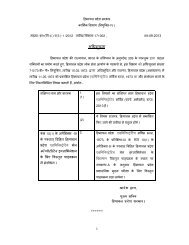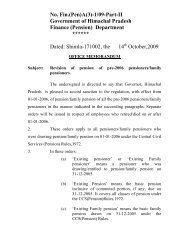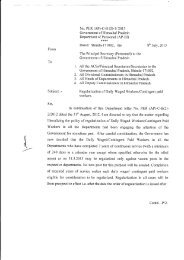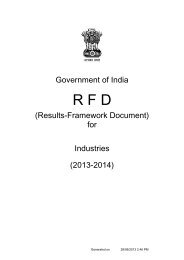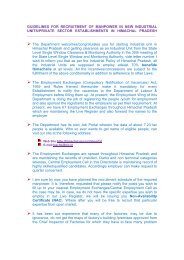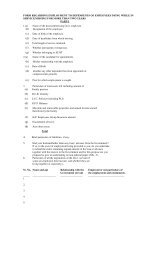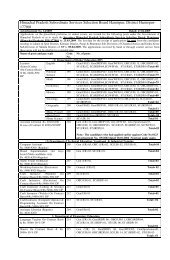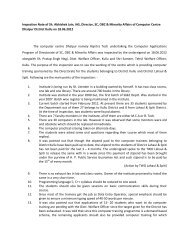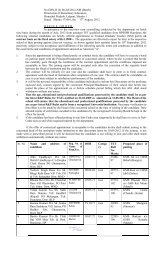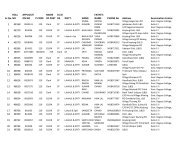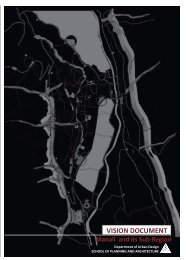Tables
Tables
Tables
Create successful ePaper yourself
Turn your PDF publications into a flip-book with our unique Google optimized e-Paper software.
Mathematics - XITime/PeriodsPeriods10Topic/ Theme Subject Matter ActivitiesUnit-ISets and Functions1. Sets Sets and theirrepresentation, types ofsets, equality of sets,subsets, subsets of the setof real numbers especiallyintervals (with notations)power set, universal set.Venn Diagrams union andintersection of sets.Difference of sets.Complement of set.Periods142. Relations andFunctions.*Ordered pairs, Cartesianproduct of sets, Number ofelements in the Cartesianproduct of two finite sets.Cartesian product of thereals with itself (uptoRxRxR).Definition of relation,pictorial diagrams, domain,Co-domain and range of arelation, Functions as aspecial kind of relation sfrom one set to another.Pictorial representation of a
o solve every quadraticequation. Brief discussion ofalgebraic properties ofcomplex numbers. Arganddiagram. Argand plane andpolar representation ofcomplex numbers.*To find the square root of acomplex nos. Cube roots ofunity. Statement ofFundamental theorem ofalgebra.Periods103. LinearInequalitiesRecall of the concept ofquadratic equations and itssolutions in real No. systemSolution of quadraticequation with realcoefficient in the complexnumber system.Linear inequalities,Algebraic solution of linerinequalities in one variableand their representation onthe number line. Graphicalsolution of linear inequalitiesin two variables. Solution ofsystem of linear inequalitiesin two variables graphically.
Periods104. Sequenceand SeriesSequence and series.Recall of the concept ofA.P. its n th term and sum ofn terms. Arithmetic mean(A.M.). Geometricprogression. General termof G.P., Sum of n terms of aG.P. , Geometric Mean(G.M.) Relation betweenA.M. and G.M. sum to nterms of the special series∑n , ∑n² , ∑n³.Periods125. Permutations& CombinationFundamental Principle ofcounting, Factorial n.Permutationandcombination derivations offormulae and theirconnections, simpleapplications.Periods86. BinomialTheoremHistory, Pascal’s Triangle,Statement and proof ofbinomial theorem forpositive integral index.General and middle term inbinomial expansion, simpleapplications.Binomial theorem for anyindex (without proof) Simpleproblems to be given.
Periods9Periods12Unit-VCo-ordinate Geometry1. Straight Lines Brief recall of 2D Coordinategeometry fromearlier classes. Slope of aline and angle between twolines. Various forms ofequation of lines: Parallel toaxes, Point Slope form,Slope intercept form, twopoint form, intercepts formand normal form. GeneralEquation of a line. Distanceof a point from a line.2. Conic Section Section of a cone, Circles,Ellipse,Parabola,Hyperbola, Point, A straightline and pair of intersectinglines as a degenerated caseof a Conic section. Standardequations and simpleproperties of Parabola,Ellipse and Hyperbola,Standard Equation of acircle: its center and radius.Conic section canbe shown to thestudents by slidingthe cone atdifferent positions.
Periods83. Introduction toThreeDimensionalGeometryCo-ordinate axes and coordinateplanes in threedimensions. Co-ordinates ofa point. Distance betweentwo points and sectionformulae.Periods181. LimitContinuity &DerivativesUnit-VICalculusConcept of limit, Algebra oflimits of polynomial andrational functions. Limits ofTrigonometric functions,Continuity of a function.Derivative introduced asrate of change both as thatof distance function andgeometrically. Definition of aderivative, related to slopeof tangent of the curve,derivative of sum,difference, product andquotient of functions,derivative of polynomial andtrigonometric function.Unit-VIIMathematical Reasoning
Periods81. MathematicalReasoningMathematically acceptablestatements. Connectingwords/phrases.Consolidatingtheunderstanding of “if andonly if” (necessary andsufficient conditions”, “implies”, and/or”, “impliedby”, “and”, “or”, “thereexists” and their usethrough variety of examplesrelated to real life andmathematics validating thestatements involving theconnecting words differencebetween contradiction,converseandcontrapositive.Periods10Unit-VIIIStatistics and Probability1. Statistics Measures of dispersion,Mean deviation, Varianceand Standard deviation ofungrouped/grouped data.Analysis of frequencydistribution with equalmeans but differentvariance.
Periods142. Probability. Recall the concept ofprobability from previousclasses.Randomexperiments : Outcomes,sample spaces (setrepresentation). Events:Occurance of events, ‘not’,‘and’, & ‘or’ events.Exhaustive envents,mutually exclusive evetns.Axiomatic (set theoretic)Probability, connectionswith the theories of earlierclasses. Probability of anevent, probability of ‘not’.Appendix1. Infinite Series Infinite geometric series,exponential and logarithmicseries.2. Mathematical ConsolidatingtheModelling understanding developedupto Class X. Focus onmodelling problems relatedto real life (Likeenvironment, travel etc.)and connecting with othersubjects of studies wheremany constraints may
need to be ignored,formulating the model,looking for solutions,interpreting them in theproblem situation andevaluating the model.
Mathematics – XIITimeFrameTopic/ Theme Subject Matter ActivitiesUNIT-I (More About Functions)1. Functions Recall of concept of functionsfrom previous class. Types offunctions i.e. One-One, ManyOne, Into and Onto functions,Composite functions, Inverse of afunction, Binary Operations.2. Inverse Definition, Range, Domain,Trigonometric Principal value, PrincipalFunctions branches, Graph of InverseTrigonometric functions,Elementary properties of InverseTrigonometric Functions.Unit-IIAlgebra1. Matrices. Concept, notation, order,equality, types of matrices, zeromatrix, transpose of a matrix,Symmetric and skew-symmetricmatrix, addition, multiplicationand multiplication of matrix by ascalar, Properties of addition,multiplication of matrices andproperties of multiplication of amatrix by a scalar. Noncommutativityof multiplication o fmatrices and existence of nonzeromatrices whose product isthe zero matrix (Restricted to
square matrices of order 2).Concept of elementary row andcolumn operation. Invertiblematrices and proof of theuniqueness of inverse if it exists(Here all matrices have realentries).2.DeterminantsDeterminants of a square matrix(upto 3x3 matrices), Properties ofdeterminants, minors, co-factorsand application of determinantsin finding the area of triangle,Adjoint and inverse of a squarematrix,consistency,inconsistency, and number ofsolutions of system of linearequations in two or threevariables (having uniquesolutions) using inverse of amatrix.Unit-IIICalculus1. Derivatives Recall of the concept ofderivatives of a function.Derivative of compositefunctions, chain rule, derivativesof inverse trigonometricfunctions, derivative of implicitfunctions, concept of exponentialand logarithmic functions andtheir derivatives. Logarithmicdifferentiation, derivative offunctions expressed in
2. Applicationsof Derivatives.parametric forms, Second orderderivatives, Roll’s andLagrange’s mean value theorms(without proof) and theirgeometric interpretations.Applications of derivatives, rateof change, increasing/decreasingfunctions, tangents and normals,approximation, maxima andminima (first derivative testmotivated geometrically andsecond derivative test given as aprovable tool). Simple problems(that illustrate basic principlesand understanding of the subjectas well as real life situations).3. Integrats Integration as inverse process ofdifferentiation, integration of avariety of functions bysubstitution, by partial fractionsand by parts, only simpleintegrals of the type :∫ dx , ∫ dx , ∫ dx ,x² ± a² √x² ± a² a² - x²∫ dx , ∫ dx , ∫dx , √a² - x² ax² + bx + c√ax² + bx + c∫ (px + q) dx , ∫ (px + q) dx,ax² + bx + c √ax² + bx + c∫ dx , ∫ dx , ∫dx , √a² - x² ax² + bx + c√ax² + bx + c∫ (px + q) dx , ∫ (px + q) dx,ax² + bx + c √ax² + bx + c
4. Applicationsof the Integrals______ ____∫ √ x² ± a² dx ∫ √x² - a² dx,__________________∫ √ax²+bx+c dx ∫ (px+q)√ax²+bx+c dx,∫ dx , ∫ dx ,a + b cosx a + b sinx∫ dx , ∫ x² + 1 dx,a + b cosx + c sinx x 4 + kx² + 1x² - 1 dx,x 4 + kx² + 1& integration of inversetrigonometric functions.Use of definite integrals in findingthe area under simple curves,especially lines, areas ofcircles/parabolas/ ellipses (instandard form only), areabetween the two above saidcurves (The region should beclearly identifiable).Unit-IVVectors & Three Dimensional Geometry1. Vectors Vectors and scalars, magnitudeand direction of a vector,Direction Cosines/ratios ofvectors, types of vectors (equal,unit, zero, parallel and collinearvectors). Position vector of apoint, negative of a vector,components of a vector, additionof vectors, multiplication of a
2. ThreeDimensionalGeometry1. LinearProgrammingvector by a scalar, positionvector of a point, position vectorof a line, position vector of apoint dividing a line segment in agiven ratio. Scalar (dot) productof vectors, projection of a vectoron a line. Vector (cross) productof vectors, Scalar triple productand vector triple product.Direction cosines/ratio of a linejoining two points, Cartesian andvector equation of a line,coplanar and skew lines, shortestdistance between two lines,Cartesian and vector equation ofa plane, Angles between (i) twolines (ii) two planes (iii) a lineand a plane. Distance of a pointfrom a plane. Sphere, its centerand radius, diameter form of theequation of a sphere.UNIT-V (Linear Programming)Introduction, related terminologysuch as constraints, objectivefunction, optimization, differenttypes of linear programmingproblems (L.P.P.). Mathematicalformulation of L.P.P. Graphica lmethod of solution for problemsin two variables, feasible andinfeasible regions. Feasible and
infeasible solutions, optimalfeasible solution (upto three nontrivialconstraints).Unit-VIProbability1.Probability Recall of the concept ofprobability from previous class.Addition and multiplicationtheorems on probability.Conditionalprobability,independent events, totalprobability. Baye’s Theorem,Random variable and itsprobability distribution, mean andvariance of random variables,Repeated independent(Bernoulli) trials and Binomialdistribution.1. Proofs inMathematicsAPPENDIXThrough a variety of examples,related to mathematics andalready familiar tothe learner, bring out differentkinds of proofs, direct,contrapositive, by contradiction,by counter example.
2.MathematicalModelingModeling real life problemswhere many constraints mayreally need to be ignored(Continuing from Class XI).However now the modelsconcerned would use techniques/ results of matrices, calculus andlinear programming.



